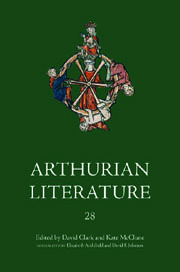Book contents
- Frontmatter
- Contents
- General Editors' Foreward
- Preface
- List of Contributors
- Abbreviations
- I Reading Malory's Bloody Bedrooms
- II (Dis)Figuring Transgressive Desire: Blood, Sex, and Stained Sheets in Malory's Morte Darthur
- III Bewmaynes: the threat from the kitchen
- IV Sibling Relations in Malory's Morte Darthur
- V ‘Traytoures’ and ‘Treson’: the Language of Treason in the Works of Sir Thomas Malory
- VI ‘The Vengeaunce of My Brethirne’: Blood Ties in Malory's Morte Darthur
- VII Malory and the Scots
- VIII Blood, Faith and Saracens in ‘The Book of Sir Tristram’
- IX Barriers Unbroken: Sir Palomydes the Saracen in ‘The Book of Sir Tristram’
- X Virginity, Sexuality, Repression and Return in the ‘Tale of the Sankgreal’
- XI Launcelot in Compromising Positions: Fabliau in Malory's ‘Tale of Sir Launcelot du Lake’
- Title in the Series
XI - Launcelot in Compromising Positions: Fabliau in Malory's ‘Tale of Sir Launcelot du Lake’
Published online by Cambridge University Press: 05 February 2013
- Frontmatter
- Contents
- General Editors' Foreward
- Preface
- List of Contributors
- Abbreviations
- I Reading Malory's Bloody Bedrooms
- II (Dis)Figuring Transgressive Desire: Blood, Sex, and Stained Sheets in Malory's Morte Darthur
- III Bewmaynes: the threat from the kitchen
- IV Sibling Relations in Malory's Morte Darthur
- V ‘Traytoures’ and ‘Treson’: the Language of Treason in the Works of Sir Thomas Malory
- VI ‘The Vengeaunce of My Brethirne’: Blood Ties in Malory's Morte Darthur
- VII Malory and the Scots
- VIII Blood, Faith and Saracens in ‘The Book of Sir Tristram’
- IX Barriers Unbroken: Sir Palomydes the Saracen in ‘The Book of Sir Tristram’
- X Virginity, Sexuality, Repression and Return in the ‘Tale of the Sankgreal’
- XI Launcelot in Compromising Positions: Fabliau in Malory's ‘Tale of Sir Launcelot du Lake’
- Title in the Series
Summary
Space in a fabliau is delimited, known, often domestic. In this regard as in so many others it is the antithesis of the romance space through which Launcelot moves in the tale that bears his name. Here space is apparently inchoate and unbounded, and the movement of the hero seemingly without pattern until he stumbles upon aventure. At that point, like someone engaged in a treasure hunt, he may begin to move through this space very differently, following a given assignment to a highly specific goal: an abbey of white monks, Terquyne's tree, the Chapel Perelus. But these directives do not change the nature of the geography, they simply give him a temporary path between two points. Looking back, we are aware that the space he traversed was fraught with significance.
Fabliau, by contrast, involves moving human beings into and out of familiar, designated, bound spaces, typically a bedchamber or kitchen and the furniture which goes with it. The quarters are cramped: there is a palpable sense that there is not enough space – certainly not enough beds – to go round. A central motif is the human body in a grotesque or ridiculous posture. The action of a fabliau may demand this position in order for someone to save himself from detection: creeping into a tub, for instance, or crouching in a window box. Alternatively, as in the case of May and Damien in Chaucer's ‘Merchant's Tale’, characters are caught in compromising positions and must quickly furnish a plausible explanation.
- Type
- Chapter
- Information
- Arthurian Literature XXVIIIBlood, Sex, Malory: Essays on the 'Morte Darthur', pp. 181 - 198Publisher: Boydell & BrewerPrint publication year: 2011



